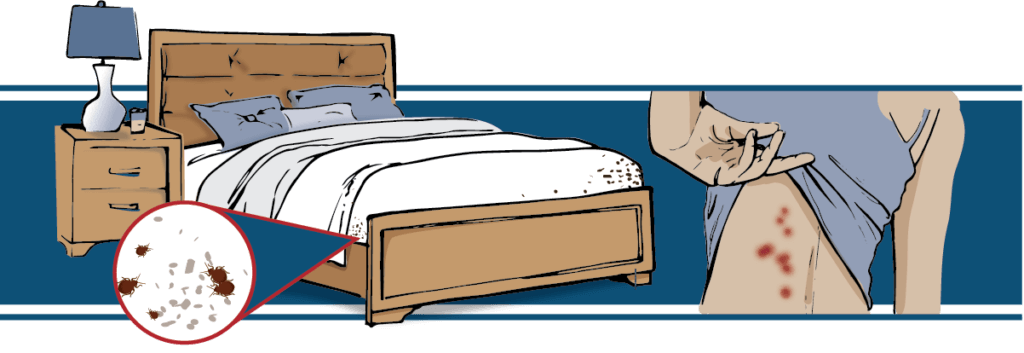One of the top complaints renters have is pests. Ants, cockroaches, bed bugs, spiders, mosquitoes, and mice all make for lousy roommates and your residents will definitely let you know their feelings about sharing living quarters with these uninvited and unwanted guests. As a property manager, your hands are already full, so why wait until the problem arises and tempers flare? Get ahead of the problem and avoid unhappy renters by creating an environment with minimal effort and minimal costs that is not so conducive to freeloading bugs.

Don’t Let The Bed Bugs Bite.
Bed bugs are notorious hitchhikers. They are opportunistic little creatures that can become a problem overnight if your resident stayed at the wrong hotel, set their backpacks down in the wrong place, or brought them home from a sleepover. Here, communication with your residents is key. Without alarming them, you can send your renters regular reminders to stand vigilant against the scourge of bed bugs. Make sure your residents know the signs. Have them look for red, rusty, or even brown spots — about the size of an asterisk — in their bedding. They may also notice a foul, musty odor. Since these bugs only really come out at night, educate them on the most common hiding spots. Aside from the obvious beds, these include dressers, suitcases, chairs, shoes, and even wall sockets. That will help lower the chances they will bring them home with them. If they do spot or smell them, take quick action and call a pest control specialist like Ace. Don’t wait and don’t try to take care of them yourself. More often than not, DIY bed bug treatments make the infestation worse.

Disrupt Transportation Routes.
Ants, as well as termites, often use tree branches and vegetation as their own personal superhighways to invade buildings. The easy solution is to have your landscaping company prune tree branches and cut vegetation. Be sure your landscapers create about an 18″ barrier to thwart the enemy’s advance so your residents can live a peaceful, pest-free existence. Mulch can also be an issue. While the material itself does not draw termites to the area, mulch spread over three inches deep creates an inviting habitat for pests – termites especially. Layers of organic matter trap heat and moisture next to the ground. Termites use this thick mulch as shelter from harsh weather. Some kinds of mulch may even repel termites. Redwood and cypress contain resins that make the wood less attractive to termites. Cedar mulch contains thujone, which is a chemical that deters insects. When it comes to termite-resistant mulch, melaleuca wood might be the best choice, as the insects will actively avoid eating it. Materials like rubber or stone also deliver the same weed and temperature control without the risk of infestation from termites in mulch. Have your landscaper work with your pest control professional since these things tend to affect each other’s industry.

Close Entry Points.
Cracks, crevices, holes, and gaps are all easy ways for a variety of pests and rodents to enter your building. Exclusion work like copper or metal mesh installation to deter larger pests from entering through places like vents and drainpipes will help. Also, having a handyman seal cracks and crevices in the building you manage will help. Having your pest control professional will work better since they will not just seal the ones they see, but they know what to look for in the first place. Netting is a humane way to take care of bats and squirrels that have made their way into your building. These strategies are all a part of a solid pest control plan that includes Integrated Pest Management. If your pest control company isn’t doing it, it’s time to find another.

The Old Watering Hole.
One of the best ways to keep mosquitos, cockroaches, and even mice at bay is to make sure there is no standing water. Mosquitoes only need a cap full of water to use as a breeding ground and cockroaches and mice are attracted to humid areas since they don’t need a lot of water to live. While your professional exterminator should not only be giving you these tips but helping to implement them, in between services you and your staff can help. Dump out any standing water that may have collected from an overnight rainstorm. Notice if there are areas in the lawn around your building that tend to collect rain and have your landscaper address them. Place dehumidifiers in humid areas like basements and boiler rooms to stave off excess moisture. These areas in particular are attractive to pests since they are low-traffic areas that provide water and shelter – two of the three things pests need to live in your building.

Look For Nests.
Stinging pests can threaten potential and future residents — especially those that have an allergy. Paper wasps, hornets, yellow jackets, and bees may try to build their nests in some of your property’s underutilized areas like clubhouses. And once guests start to assemble again, those nests can become extremely dangerous and the insects inside them may become aggressive when defending their homes.
An Ounce Of Prevention Is Worth A Pound Of Cure.
Finally, invest in your residents’ happiness and well-being with a monthly maintenance treatment. This is a very affordable and effective way to keep pests at bay and you from having to deal with unhappy residents. It’s definitely worth your while to at least get an estimate. Schedule yours here.